26 Apr Honduras — Into the Abyss in a Homemade Submarine
You wouldn’t think it would be possible to get expelled from reform school, but Karl Stanley managed it. Not without attracting attention, though. The attention landed him in a mental hospital where he was diagnosed with what Karl remembers as defiance-of-authority syndrome. Defiance-of-authority syndrome not, apparently, being listed in the Diagnostic and Statistical Manual of Mental Disorders, Karl was released to do his worst upon unsuspecting authority figures. He was in good company, ocean-o-nautwise. Jacques Cousteau was expelled from high school, too.
We didn’t know anything about Karl when we were walking along the beach on Roatan Island in Honduras and saw his sign: World’s Deepest Tourist Submarine. We also didn’t know that Karl was in Roatan because, well, things like World’s Deepest Tourist Submarines aren’t as highly regulated in Honduras as they are in Florida where he’d started out. Or, that some of the things he did on Roatan were rumored to violate Honduran law.
What we did know was that Roatan sits so close to the world’s second-largest barrier reef that you can stand on the dock and throw a rock into half-mile-deep water.
And that we had a free day coming because the last day of a dive trip is always a free day. That gives your blood time to air out. That way you’re not overloaded with nitrogen and don’t get the bends during the plane ride home.
Something else we . . . or, at least, I . . . knew was that I wanted to get into that submarine. And I wanted to ride it down the world’s second longest barrier reef into the abyss. So I walked over to check it out.
Marine architecture is not my field. Karl and I were even on that score because it isn’t his field, either. His field, at least his academic accomplishment, is an undergraduate degree in history from Eckerd College. But there was something about the man. Precise. Thorough. An air of carefulness . . . that encouraged confidence.
And the submarine, the Idabel herself, she was one seductive lady. We all carry inside ourselves a sense of craftsmanship and looking at her, she was beautifully put together . . . at least to someone who didn’t really know how submarines are put together. For me, it was love at first sight.
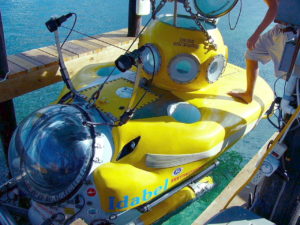
Idabel: the world’s deepest tourist submarine
Idabel was the exact vessel I imagined myself going to the bottom of the ocean in. Then I went into Karl’s house, and that sealed the deal . . . because there wasn’t anything inside his house.
The place had the usual complement of bedrooms, a living room, a dining room and a study or a bonus room or whatever real estate salespeople call extra, undefined spaces in homes. It was hard to tell what the rooms were for because there wasn’t any furniture to provide clues. Only a mattress tossed on the floor of what, under a different occupant, would probably have been the dining room.
This man doesn’t care about his house, was my first thought. He only cares about his submarine.
Most people care about other things than just submarines, was my next thought.
He has Asperger’s, I persuaded myself on the evidence of absence of furniture. People with Asperger’s have superpowers. Television shows always portrayed people with Asperger’s as having superpowers.
That’s IT, I thought. Karl’s superpower is building homemade submarines.
I went back outside and signed up my kids and me to descend into the abyss in Karl’s submarine. Peggy, who was not as educated in the ways of medical science as portrayed by TV scriptwriters, refused to have anything to do with the business.
Forty-eight hours later, the kids and I were crouched in the Plexiglas bubble at the front of the Idabel as we motored across the harbor toward the drop point.
Peggy, watching from the dock, was trying to contact Karl by ESP. Karl, she was transmitting, close the hatch.
KARL. Close the hatch!
Close it Karl. CLOSE THE HATCH!
Now Karl. Close it NOW!
Karl must have had his ESP receiver switched off, because he didn’t hear. But other people were monitoring Peggy’s frequency. “Karl,” the kids and I heard the harbormaster say over the radio as we started our descent, “you have to close the hatch.”
The Idabel dropped down through the daylight zone past the kind of reef fish we were used to seeing
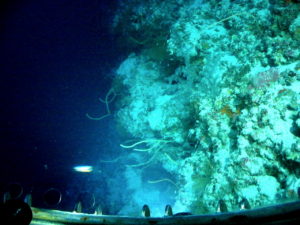
View from the Plexiglas bubble at the front of the Idabel
into the twilight zone.
And down into the dark where the only light was from the lamps mounted above the Plexiglas bubble.
A hundred-and-fifty feet is the deepest I have ever been in SCUBA gear. That was in the Red Sea off the coast of Sudan and it was too deep. I’m not doing that again. Still, I have some familiarity with the things you can see in the first hundred-and-fifty feet of ocean. The reef fish and corals, the anemones and sea fans and turtles. The colors and textures, the flashes and sparkles and movement in dappled waters don’t prepare you for what lies in the darkness below.
Down there, you can still recognize some of the things. Soft corals
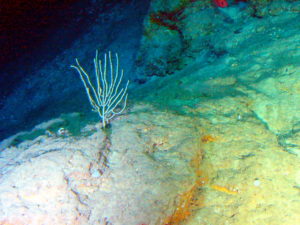
A soft coral deeper than I expected corals to be
and spidery-looking sea stars but, in the light from the Idabel, everything looked pale. And there were other things I’d probably seen pictures of, but couldn’t recognize in real life.
Karl knew them all and he told us, but I wasn’t taking notes. I was staring out through the Plexiglas too entranced to write anything down. Some of what we saw didn’t even look like it belonged in the modern world.
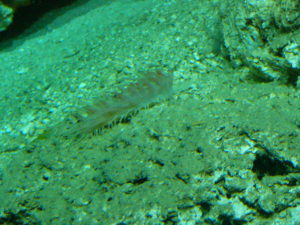
I have no idea what this is but, to me, it looks like one of those Hallucigenia dug up in the Burgess Shale.
Other things I can name because they look like their names.
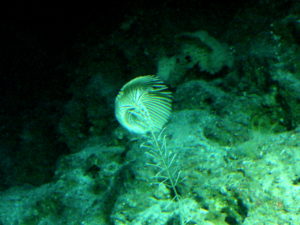
Sea lily: a crinoid related to starfish and sea urchins. Who would have guessed?
We came back up along the face of the reef. At about 275 feet Karl spotted an air tank and a weight belt and a buoyancy control device that had been abandoned by a blissed-out diver.
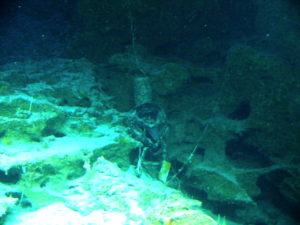
Gear left behind by a diver who enjoyed the feeling of nitrogen narcosis way too much
Karl knew his name. He may have even known the guy personally. He’d been famous for enjoying the feeling of nitrogen narcosis, going deeper and deeper until one day at the 250-foot level he’d become so euphoric he removed his equipment and swam away. His body was nearby, although it hadn’t stood the test of time as well as his gear, and it was hard to spot.
Despite the yammering about reform schools and a loose regulatory environment and lack of paper qualifications, I think Karl Stanley has done something truly wonderful. With all his work, all his struggling against other peoples’ rules, all his single-minded devotion to detail, he made it possible for my kids and me to go somewhere we never could have gone otherwise, and see things we never would have seen. And for that, I heartily thank him.


No Comments